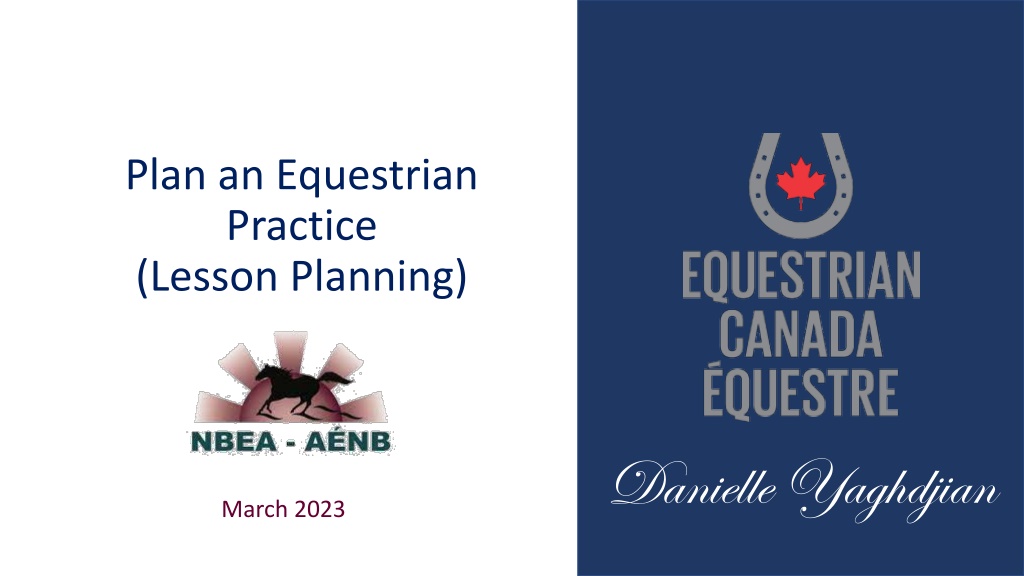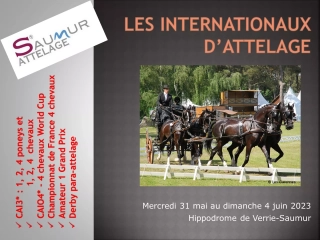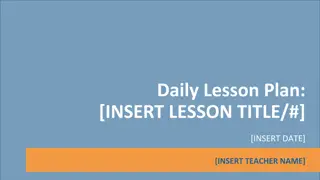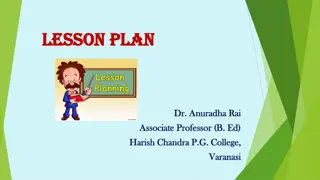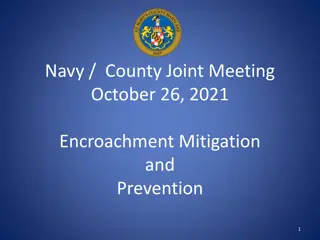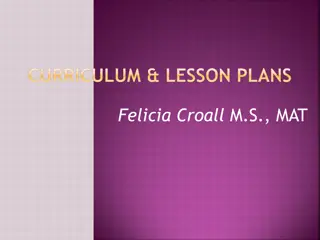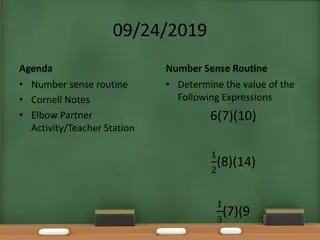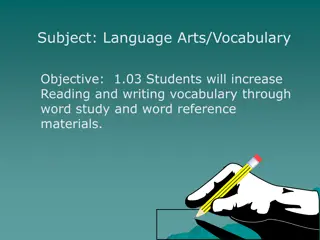Comprehensive Guide to Building an Effective Equestrian Lesson Plan
This comprehensive guide covers the key aspects of planning an equestrian lesson, including logistics, warm-up, demonstration, progressions, and conclusion. It emphasizes the importance of safety, clear communication, and tailored activities to enhance skills. The guide provides insights into structuring lesson plans, setting goals, assessing rider skill levels, and incorporating appropriate equipment. Whether for flat, unmounted, or jump topics, following this guide ensures a well-rounded and engaging equestrian practice session.
Download Presentation

Please find below an Image/Link to download the presentation.
The content on the website is provided AS IS for your information and personal use only. It may not be sold, licensed, or shared on other websites without obtaining consent from the author. Download presentation by click this link. If you encounter any issues during the download, it is possible that the publisher has removed the file from their server.
E N D
Presentation Transcript
Plan an Equestrian Practice (Lesson Planning) Danielle Yaghdjian March 2023
INSTRUCTOR PORTFOLIO Lesson Plans The Instructor Portfolio Plan a Practice consists of: Two written lesson plans focused on a topic that is assigned to you by NBEA (flat lesson & unmounted). One lesson plan focused on a jump topic that is assigned to you by NBEA (if applicant is working towards Instructor Jump)
An Effective Lesson Plan The written lesson plan outcomes are focused on the organization of a series of lesson activities (in a written plan) that enhances the learning of one or more skills. The lesson plan is designed for a one hour long lesson. Information in the plan can be in point form or written as if the coach is talking, as long as it has all of the criteria from the Rubrics. An effective lesson plan must take into consideration the following aspects: Logistics and Structure Goals and Objectives Athletes involved (horse and human) Safety
Building a Lesson Plan 1. 2. 3. 4. 5. 6. 7. 8. Logistics Introduction Warm-up Explanation Demonstration Progressions Cool-down Conclusion
Building a Lesson Plan Building a Lesson Plan Logistics Introduction Warm-up Explanation Demonstration Progressions Cool-down Conclusion Logistics Coaches name Information of the lesson schedule (date, time, location, # of riders) Information on the athletes skill level Lesson logistics (prep, goals, key elements, equipment list, safety consideration, arena set up
Building a Lesson Plan Building a Lesson Plan Logistics Introduction Warm-up Explanation Demonstration Progressions Cool-down Conclusion Introduction The Introduction should take 2-3 minutes Facility check and Risk Management Review of Safety Rules Introduction of the instructor/coach and the riders; ask about potential medical issues (inhalers, epi-pens) 2 way communication Ask questions and require more than a yes or no Mounted/Drive Lesson - Tack check; stirrup length, girth tension, helmet/footwear, harness/vehicle check, whip length, etc.
Building a Lesson Plan Building a Lesson Plan Does not meet criteria in the marking tools Introduction Introduce myself. Ask each student their name, which horse they are riding. Check that all tack. Introduction lesson topic
Building a Lesson Plan Building a Lesson Plan Does meet criteria in the marking tools Introduction Do a quick safety check of tack and equipment checking the saddle, girth, stirrup length, fit of the bridle, helmet and harness and footwear. Ask each student how they are feeling today? Do they have any medical issues? (inhaler, epi-pen) Introduce myself, ask the riders what their names are, what their horses names are and if they have ridden them before. Explain that today they are going to work on posting to the trot. Check the arena for safety hazards (gates closed, equipment not being used stored safely, safe footing. Remind students of basic riding safety rules (leaving at least one horse length between you and the other riders, circle or cross the arena if your too close to the horse in front of you. Always pass to the inside. If at anytime there is an emergency in or outside the arena please come to the center and halt, dismount if safe to do so.
Building a Lesson Plan Building a Lesson Plan Logistics Introduction Warm-up Explanation Demonstration Progressions Cool-down Conclusion Warm Up The Warm up should take 8-15 minutes. Does the warm-up link to the main part of the lesson? Is it developmentally appropriate? Are the skills sequenced properly?
Building a Lesson Plan Building a Lesson Plan Does not meet criteria in the marking tools Warm Up Have the students walk around the ring, make sure that its a working walk and that the horses are listening to the riders aids. Practice steering with the weave pylons. Have the students practice standing up in their stirrups, pushing the weight into their heels.
Building a Lesson Plan Building a Lesson Plan Does meet criteria in the marking tools Warm Up Riders will warm up with exercises that will prepare them for the trot exercise. Through the warmup I will gauge where each rider s capabilities stand and assess the horse s suitability for the lesson. Riders will begin on the rail on the left rein at the walk, and practice the sequence of seat, leg, hand in walk/halt/walk progressive transitions. Repeat in the other direction. Review steering aids with the students and have them practice walking down the quarter line steering around a cone. After successful completion, riders will progress to riding the same sequence of aids for a short trot transition from a walk. Riders will be assessed if this can be done with tangent points In a group, if not it will be done individually.
Building a Lesson Plan Building a Lesson Plan Logistics Introduction Warm-up Explanation Demonstration Progressions Cool-down Conclusion Explanation The explanation should take 1-2 Minutes An explanation of the skill to be learned/practiced the lesson objective - (WHAT) An explanation of: - WHY the skill is important (CC & CCS relate skill to competition) - HOW the skill is accomplished (Aids) i.e. appropriate activities progressively sequenced to promote learning, safety and success - WHERE the skill will be practiced i.e. arena/venue diagram and/or description to show where activities occur - WHEN the skill will be practiced i.e. explanation of when the riders attempt activity described/explained Two way communication list some questions that might be asked and list your desired answers to questions
Building a Lesson Plan Building a Lesson Plan Does not meet criteria in the marking tools Explanation Tell the students that they are going to be learning posting trot. The posting trot is when you move up (butt out of the saddle) and down (butt in the saddle) while the horse is trotting.
Building a Lesson Plan Building a Lesson Plan Does meet criteria in the marking tools Explanation Explain to the group that today they will be learning how to post to the trot. Ask the students, does anyone remember how many beats there are in a trot? Answer: The trot is a 2 beat gait Because the trot is two beats, it can make it feel bouncy. Today we are going to learn the posting trot. A posting trot is when you rise your seat out of the saddle and then sit in the saddle with the horses two beat motion. This will make that bounce feel more comfortable for you and your horse will feel more balanced. Today I have set up the arena with markers to help you identify when you will do your transitions. You will ask for the sit trot at the first marker (shorten the reins, sit deep into the saddle, squeeze with both legs at the girth). and then when you reach the first pylon you will post (stand up and sit down in the saddle with each stride). I want you to count out loud the two beat rhythm (1-2, 1-2, 1-2). We will count the beats together until you find the rhythm and can feel when to rise and sit. At the second pylon I want you to ask your horse to walk (sit down in the saddle, stretch tall, take pressure with both reins and say whoa) Q&A: Q: How many beats is a trot? A: Two. Q: How do you post to the trot? A: Go up and down in the saddle
Building a Lesson Plan Building a Lesson Plan Logistics Introduction Warm-up Explanation Demonstration Progressions Cool-down Conclusion Demonstration The demonstration should take 3-5 Minutes Should include: A demonstration of the first progression from beginning to end. Reinforcement of the aids or key elements i.e. Counting and maintaining rhythm in trot, observing diagonal legs Describe points of reference and tangent points Goals/objectives of a well-executed skill i.e. Skill learned to be repeatable at least two out of three times with some degree of proficiency
Building a Lesson Plan Building a Lesson Plan Does not meet criteria in the marking tools Demonstration Explain the the rider will go to the rail and then pick up a trot a the first marker.. Once at the trot they will stand up to post and then sit down to the second marker and then walk.
Building a Lesson Plan Building a Lesson Plan Does meet criteria in the marking tools Demonstration The lesson students will stay lined up in the centre of the arena (with safe spacing) to watch. They will be facing towards me as I demonstrate so they can see and hear. I will walk to the first marker (LETTER H) and show them this is where they pick up a sitting trot by shortening the reins, sitting deep into the saddle, squeezing with both legs at the girth. I will then walk to the second marker (PYLON) and explain that this is where they will post to the trot by standing up and sitting down in the saddle with each stride. I will then get the students to count out loud the two beat rhythm (1-2, 1-2, 1-2) as I demonstrate with my body. When I get to the second pylon I explain that this is where they will ask the horse to walk by sitting down in the saddle, stretching tall, taking pressure with both reins and say whoa) The goal is to keep the horse trotting and to be able to hold the post between the markers
Ring Setup K E H #1 Sit Trot #2 Post Trot #3 Walk C A Students F B M
Building a Lesson Plan Building a Lesson Plan Logistics Introduction Warm-up Explanation Demonstration Progressions Cool-down Conclusion Progressions Each progression should take 10-15 minutes Outlines the activities and skill(s) to be developed/practiced. (The 2nd and 3rd progressions will build on these skill(s).) Progressions should include: Objective/goal of each progression outline what you want to see as an outcome for the progressions. A clear description of the exercise/activity to be used to develop/practice the desired skill(s) Key factors (use of aids, rider s position and balance, eyes, etc) the candidate will be observing; possible concerns and corrections that could be made and reinforced as required Outline teachable points/moments (opportunity for all to learn) that can be used to educate riders Safety reminders as required. CC & CCS relate skill to competition.
Building a Lesson Plan Building a Lesson Plan Does not meet criteria in the marking tools Progressions #1 Send the students to the rail and have them pick up the trot. Once at the trot they can try to post, stand up sit down. #2 At the posting trot have the students check to see if they are on the correct diagonal. #3 - Same exercise on the right rein.
Building a Lesson Plan Building a Lesson Plan Does meet criteria in the marking tools Progression #1 (4-5 Minutes) Goal: to initiate the up-down movement of the seat in a controlled environment At the standstill the riders will push the weight into the stirrups and stand up for the count of one and then sit for the count of two. While they are doing this I will make sure I m standing close by to prevent the horse from walking away and will keep count with them (one two one two). Safety: I will make sure the horses are evenly spaced. Positional Corrections: I will make sure the riders hands are not pulling on the horses mouth by having them hold the pommel of the saddle. I will remind the students to maintain their basic position: weight is in the heels, eyes are straight ahead and the body is tall. Outcome: the riders show they can maintain the one (up) two (down) rhythm while maintaining their position.
Building a Lesson Plan Building a Lesson Plan Does meet criteria in the marking tools Progressions #2 (6-8 Minutes) Goal: to develop the up-down movement of the seat in motion .- Riders will be halted on the rail on the left rein with the lead horse lined up at the letter C. One at a time they will walk to the first marker at H and pick up a sitting trot (even contact with both hands, squeeze with the leg at the girth, cluck with the voice if needed to get an upward transition to the trot). Once at the trot the riders will push the weight into the stirrups and keep the leg on the horse to keep the trot going to the second marker where they will start to post to the beats. They will post by standing up for the count of one and then sit for the count of two all the way to the third marker at K. (counting, one two one two). At the third marker they will bring their horse back to the walk by sitting in the saddle, pull with both reins to get the walk transition and saying whoa. Safety: I will remind the students to keep 2 horse lengths in between them. I will be positioned so I can see all the riders. Positional Corrections: I will remind the students to keep their hands quiet so they are not pulling on the horses mouth. I will remind the students to maintain their basic position: weight is in the heels, eyes are straight ahead and the body is tall. Outcome: the riders show they can maintain the one (up) two (down) rhythm while maintaining their position in movement.
Building a Lesson Plan Building a Lesson Plan Logistics Introduction Warm-up Explanation Demonstration Progressions Cool-down Conclusion Cool Down The cool down should take 5-10 minutes Is it developmentally appropriate? Is it sequenced properly? A description of how the cool down will be conducted A description of a game if appropriate for this lesson.
Building a Lesson Plan Building a Lesson Plan Does not meet criteria in the marking tools Cool Down Have the students walk on a long rein to stretch out their horses.
Building a Lesson Plan Building a Lesson Plan Does meet criteria in the marking tools Cool Down To the left have the students walk on a loose rein, making sure they still have enough contact for control if the horse should spook or go forward. Ask them to drop their left stirrup, stretch the leg, then rotate the ankle. Change direction and repeat. While they are cooling down start the conclusion of the lesson.
Building a Lesson Plan Building a Lesson Plan Logistics Introduction Warm-up Explanation Demonstration Progressions Cool-down Conclusion Conclusion The conclusion should take 3-5 minutes. List sample questions to ask, What did you learn or what were you reminded about in this lesson? Relate the lesson topic s skill to future training/lessons. CC and CCS should relate the lesson topic s skills to specific competition environments. Do not repeat the entire lesson!
Building a Lesson Plan Building a Lesson Plan Does not meet criteria in the marking tools Conclusion Tell the students they did a good job with today s lesson. Remind them that the posting trot is a 2-beat gait where the rider goes up and down in the saddle.
Building a Lesson Plan Building a Lesson Plan Does meet criteria in the marking tools Conclusion Reiterate the goals and achievements of the lesson with each rider. Ask riders to recap to demonstrate their understanding of the lesson. Why do we post to the trot? How many beats is a trot? What are the aids and preparation of aid for the skill? Did you find yourself successful today? What about your horse specifically makes this exercise easy/difficult? Let the students know that in their next lesson they will practice posting to the trot for a longer duration
Things to Consider Things to Consider Safety Consider safety in every part Add notes to each part of the practice to ensure participant safety Outline in detail the safety check that you do with tack and equipment Add facility safety check and risk management - facility check (removal of potential hazards, closed gates, etc) Add the review of arena/venue safety rules as they apply to the lesson Add the safety considerations you would need to think about for each progression
Things to Consider Things to Consider Lesson plans are part of the Coaches Portfolio that needs to be submitted ahead of time to the Evaluator. Topics are assigned a minimum of two weeks before the evaluation. Candidates have one week to submit. Feedback will be provided on portfolio outcomes as soon as these are received and evaluated. Candidates will provide missing information or make corrections as soon as the feedback is received from the evaluator until the outcome(s) meet the minimum standard.
Things to Consider Things to Consider Re-evaluations requiring more than two (2) responses from the evaluator to the candidate may result in additional evaluation fees. If the candidate requires many revisions to prepare an appropriate portfolio, evaluation may not be recommended prior to additional training being completed. The areas in which more practice/training is required will be clearly outlined to each candidate in the feedback as well as a pre-brief and debrief session. An action plan for further training to enhance performance and/or plan for the future will also be provided to the candidate.
